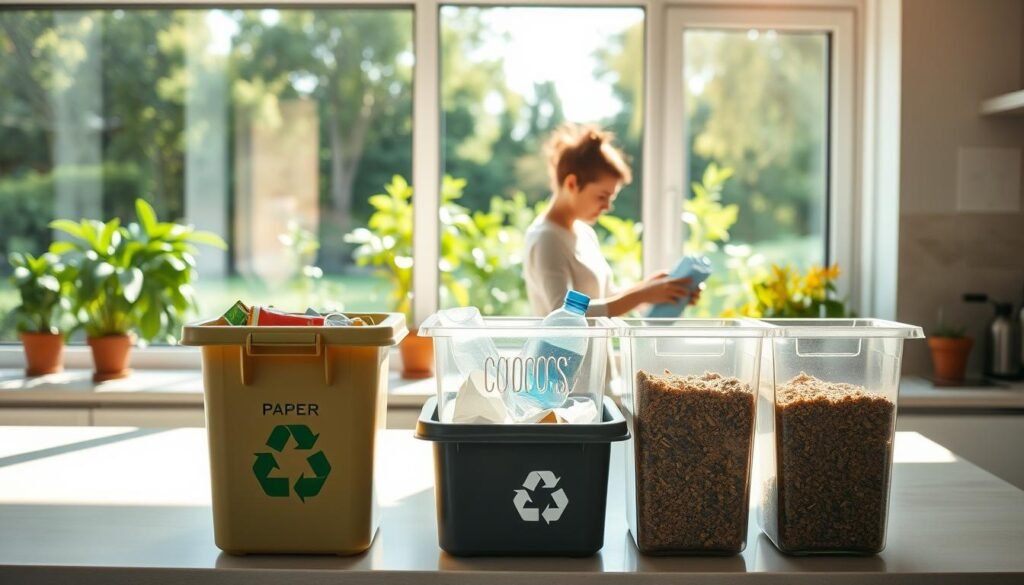Australia has made significant strides in waste management with the introduction of new waste management regulations AU in 2025. As part of the country’s efforts to reduce waste and promote sustainability, the government has implemented changes to the way Australians recycle and dispose of waste.
The new regulations aim to reduce waste and increase recycling rates. According to the latest updates, the Australian government has taken a significant step towards a more sustainable future by phasing out problematic plastics and banning the export of waste materials.
Key Takeaways
- New waste management regulations are effective from 2025.
- The export of waste materials, including plastics and glass, will be progressively banned.
- Manufacturers and retailers are encouraged to take greater responsibility for product disposal.
- The Recycling Modernisation Fund will support infrastructure development for recycling.
- $20 million in funding is allocated to expand product stewardship schemes.
The Evolution of Waste Management in Australia
Waste management in Australia has evolved substantially, shaped by changing policies and community expectations. The country’s approach to handling waste has transformed over the years, reflecting broader environmental concerns and societal shifts.
Historical Context of Waste Management Policies
Australia’s waste management history is marked by a gradual shift from rudimentary waste disposal methods to more sophisticated and environmentally conscious practices. In the early 20th century, waste management was primarily focused on dumping waste in landfills or open areas, with little consideration for environmental impact.
As environmental awareness grew, so did the need for more structured waste management policies. By the late 20th century, Australia began implementing recycling programs and waste reduction strategies, laying the groundwork for more comprehensive reforms.
Key Milestones Leading to the 2025 Reforms
Several key milestones have led to the 2025 waste management reforms in Australia. Significant developments include the establishment of the National Waste Policy in 2009 and subsequent action plans aimed at reducing waste and increasing recycling rates.
| Year | Milestone | Impact |
|---|---|---|
| 2009 | National Waste Policy | Set national targets for waste reduction and recycling |
| 2018 | National Waste Policy Action Plan | Outlined specific actions for achieving waste reduction targets |
| 2025 | Revised National Waste Policy Framework | Introduces new recycling targets and extended producer responsibility |
The journey towards the 2025 reforms has been marked by increasing recognition of the need for a circular economy and more effective waste management practices. These milestones have paved the way for significant changes in Australia’s waste management landscape.
Current Recycling Laws in Australia Before 2025
Prior to 2025, Australia’s recycling laws were governed by a complex set of national and state-level policies. The country’s approach to waste management and recycling was multifaceted, involving various stakeholders and regulations.
The National Waste Policy Action Plan
The National Waste Policy Action Plan was a significant step towards improving Australia’s waste management and recycling capabilities. Implemented in 2018, it outlined a comprehensive framework for reducing waste and promoting recycling across the country. The plan included 48 actions to be undertaken by different levels of government and industry stakeholders.
A key aspect of the plan was the establishment of national targets for waste reduction and recycling. These targets aimed to reduce the amount of waste sent to landfills and increase the recycling rate.
| Target | Description | Timeline |
|---|---|---|
| Reduce waste sent to landfills | Decrease the amount of waste disposed of in landfills | 2025 |
| Increase recycling rate | Boost the national recycling rate | 2030 |
State-Level Regulations and Inconsistencies
Despite the National Waste Policy Action Plan, state-level regulations varied significantly, leading to inconsistencies in waste management practices across Australia. Each state had its own set of rules and guidelines for recycling, which sometimes caused confusion among residents and businesses.

For instance, the recycling bin systems differed between states, with some using a three-bin system and others using a two-bin system. This inconsistency highlighted the need for a more unified approach to waste management and recycling.
The 2025 National Waste Policy Framework: Core Changes
A new era in waste management begins with the 2025 National Waste Policy Framework, bringing about core changes to Australia’s recycling laws. This framework is designed to address the growing concerns over waste management and environmental sustainability.
Key Objectives and Targets
The 2025 National Waste Policy Framework outlines several key objectives and targets aimed at reducing waste and enhancing recycling rates across Australia. These include increasing the national waste recycling rate to 80% by 2030 and reducing the amount of waste sent to landfills by 50% over the next decade.
As emphasized by the Australian Government, “A coordinated national approach is crucial for tackling the complex issues surrounding waste management and recycling.”
Governance Structure and Enforcement
The framework proposes a strengthened governance structure to oversee the implementation of the new waste management regulations. This includes the establishment of a National Waste Management Authority to monitor compliance and enforce the regulations across different states and territories.
Funding Mechanisms for Implementation
To support the implementation of the 2025 National Waste Policy Framework, the government has proposed several funding mechanisms. These include a waste levy on industries that generate significant amounts of waste and grants for local councils to improve their waste management infrastructure.
The new framework represents a significant step forward in Australia’s efforts to improve waste management and recycling. By setting clear objectives, strengthening governance, and providing funding mechanisms, the government aims to create a more sustainable and environmentally friendly waste management system.
Major Changes to Recycling Laws in Australia in 2025
As of 2025, Australia’s recycling laws have undergone substantial revisions, reflecting the country’s commitment to environmental sustainability. The new regulations aim to significantly improve waste management practices across the nation.
New Material Recovery and Recycling Targets
The 2025 National Waste Policy Framework introduces ambitious targets for material recovery and recycling. By 2030, Australia aims to recover and recycle at least 80% of its waste, significantly reducing the amount sent to landfills. This target will be achieved through a combination of improved recycling infrastructure and increased public awareness campaigns.
Extended Producer Responsibility Schemes
A key component of the new recycling laws is the implementation of Extended Producer Responsibility (EPR) schemes. EPR requires manufacturers to take responsibility for the waste generated by their products. This includes designing more sustainable packaging, investing in recycling technologies, and contributing to waste management costs. The EPR schemes will be phased in over the next five years, starting with priority product categories such as electronics and batteries.
Landfill Reduction and Diversion Measures
The new laws also focus on reducing landfill waste through diversion measures. The government will implement a landfill levy, which will increase the cost of disposing of waste in landfills. This economic incentive is designed to encourage businesses and households to adopt more sustainable waste management practices, such as recycling and composting. Additionally, the government will invest in infrastructure to support waste diversion, including advanced recycling facilities and organic waste processing plants.
The changes to Australia’s recycling laws in 2025 represent a significant step towards a more sustainable future. By setting ambitious recycling targets, implementing EPR schemes, and reducing landfill waste, Australia is poised to make a substantial impact on reducing its environmental footprint.
State-by-State Breakdown of New Recycling Regulations
With the introduction of the 2025 National Waste Policy, Australian states are tailoring recycling regulations to their specific needs. This state-by-state approach allows for more effective waste management, addressing regional challenges and opportunities.
New South Wales Updates
New South Wales has introduced a Container Deposit Scheme, encouraging recycling through financial incentives. The state aims to increase its recycling rate by 40% by 2030.
Victoria’s Circular Economy Framework
Victoria’s framework focuses on reducing waste through design innovation and recycling technologies. The state plans to achieve a 70% recycling rate for municipal waste by 2025.
Queensland’s Zero Waste Strategy
Queensland is implementing a Zero Waste Strategy, emphasizing waste reduction and recycling. Key initiatives include improving recycling infrastructure and promoting community awareness.
Western Australia’s Sustainability Approach
Western Australia is adopting a sustainability-focused approach, integrating recycling into its broader environmental policies. The state aims to reduce landfill waste by 50% by 2030.
Changes in Other States and Territories
Other states and territories are also implementing new recycling regulations. For instance, South Australia is enhancing its container deposit scheme, while Tasmania is focusing on organic waste recycling.
| State/Territory | Key Initiative | Target |
|---|---|---|
| New South Wales | Container Deposit Scheme | 40% recycling rate by 2030 |
| Victoria | Circular Economy Framework | 70% municipal waste recycling by 2025 |
| Queensland | Zero Waste Strategy | Improved recycling infrastructure |
| Western Australia | Sustainability Approach | 50% landfill reduction by 2030 |
Household Waste Management Under the New Laws
The introduction of the new national waste policy framework in 2025 is set to revolutionize household waste management in Australia. As part of the new recycling laws in Australia, households will experience significant changes aimed at improving waste reduction and recycling rates.
The Standardised Multi-Bin System
A key component of the new household waste management system is the standardised multi-bin system. This system is designed to simplify recycling practices across different regions.
Colour Coding and Accepted Materials
The new system will feature a standardized colour coding scheme to reduce confusion among households. For instance, recyclables will be collected in blue bins, while general waste will go into red bins. The specific materials accepted in each bin will be clearly communicated through public awareness campaigns.
Collection Frequency Changes
Under the new regulations, the frequency of waste collection may change. For example, some areas may see an increase in the frequency of food and garden organics (FOGO) collections. Households will be notified in advance of these changes to ensure a smooth transition.
Special Handling Requirements for Problem Wastes
Certain types of waste, such as electronic waste and hazardous materials, will require special handling. Households will be provided with guidelines on how to dispose of these items properly, including designated drop-off locations and collection events.
Food and Garden Organics (FOGO) Requirements
The new laws emphasize the importance of diverting organic waste from landfills through FOGO collections. Households will be encouraged to participate by separating food scraps and garden waste, which will then be composted or used to generate energy.

| Waste Type | Bin Colour | Collection Frequency |
|---|---|---|
| Recyclables | Blue | Fortnightly |
| General Waste | Red | Weekly |
| FOGO | Green | Weekly |
Commercial and Industrial Compliance Requirements
The 2025 reforms to Australia’s recycling laws bring significant changes for businesses, necessitating a thorough review of compliance obligations. Commercial and industrial entities must now adhere to stricter regulations to minimize their environmental footprint.
To ensure compliance, businesses need to understand the new requirements in detail. This includes new reporting and auditing obligations, industry-specific waste management plans, and the penalties associated with non-compliance.
New Reporting and Auditing Obligations
Under the new laws, commercial and industrial entities are required to maintain detailed records of their waste management practices. This includes regular audits to ensure compliance with the regulations. Businesses must submit annual reports detailing their waste reduction strategies and achievements.
Industry-Specific Waste Management Plans
Different industries have unique waste management needs. The new regulations require businesses to develop industry-specific waste management plans tailored to their operations. For example, construction companies must implement plans to minimize and recycle construction waste, while manufacturers must adopt practices that reduce industrial waste.
Penalties and Enforcement Mechanisms
To ensure compliance, the new laws introduce significant penalties for non-compliance. Businesses that fail to adhere to the regulations may face fines and other enforcement actions. The government will conduct regular inspections to monitor compliance and enforce the new regulations.
| Industry | Waste Management Requirement | Penalty for Non-Compliance |
|---|---|---|
| Construction | Minimize and recycle construction waste | $10,000 fine |
| Manufacturing | Adopt practices to reduce industrial waste | $15,000 fine |
| Retail | Implement recycling programs for packaging waste | $8,000 fine |
The National Ban on Single-Use Plastics
As part of its commitment to environmental sustainability, Australia has announced a nationwide ban on single-use plastics, effective 2025. This move is a significant step towards reducing plastic waste and promoting a cleaner environment.
Banned Items
The new recycling policy includes a comprehensive list of single-use plastics that will be banned. These include:
- Plastic straws
- Plastic bags
- Stirring sticks
- Cutlery made from plastic
- Plates and bowls made from plastic
Implementation Timeline
The implementation of the ban will be rolled out in phases to ensure a smooth transition for businesses and households. The timeline is as follows:
| Sector | Implementation Date |
|---|---|
| Food and Beverage Industry | January 2025 |
| Retail Sector | March 2025 |
| Households | July 2025 |
Government-Approved Sustainable Alternatives
The government has approved several sustainable alternatives to single-use plastics. These include:
“The shift towards sustainable materials is not just a trend, it’s a necessity. We’re seeing a rise in innovative products made from bioplastics, recycled materials, and natural fibers.”
Some examples of these alternatives are:
- Reusable bags made from cotton or jute
- Stainless steel or bamboo straws
- Biodegradable cutlery made from plant-based materials
By transitioning to these alternatives, Australians can significantly reduce their plastic footprint and contribute to a more sustainable future.
E-Waste and Hazardous Materials Management
The management of electronic waste and hazardous materials is becoming increasingly important under Australia’s evolving recycling regulations. As technology advances and consumption patterns change, the need for effective e-waste management has never been more critical.
Electronic Waste Collection and Processing Systems
Australia is implementing new electronic waste collection and processing systems to handle the growing volume of e-waste. This includes designated collection facilities and partnerships with manufacturers to ensure responsible disposal.
The new systems aim to improve recycling rates and reduce the environmental impact of e-waste. According to recent data, “the proper recycling of e-waste can recover valuable materials worth millions of dollars annually.”
“The proper recycling of e-waste can recover valuable materials worth millions of dollars annually.”
| Material | Recovery Rate | Economic Value |
|---|---|---|
| Gold | 80% | $1.2 million/ton |
| Copper | 90% | $6,000/ton |
| Palladium | 95% | $2.5 million/ton |
Battery and Light Recycling Requirements
New regulations also focus on the recycling of batteries and lights. Consumers are encouraged to return used batteries and lights to designated collection points, ensuring they are recycled properly.
Key requirements include:
- Separation of batteries and lights from general waste
- Use of designated collection bins
- Partnerships with retailers for collection services
Chemical and Hazardous Waste Disposal Protocols
The disposal of chemical and hazardous waste is strictly regulated under the new laws. Protocols include secure storage, transportation, and disposal by licensed facilities.
Industries generating hazardous waste are required to implement waste minimization strategies and adhere to strict disposal guidelines to prevent environmental contamination.
Practical Steps to Comply with New Recycling Laws in Australia
The introduction of new recycling laws in Australia marks a significant shift towards more sustainable waste management. As the country moves towards a more circular economy, households and businesses must adapt to the changes. Compliance with the new regulations is not only mandatory but also beneficial for reducing environmental impact.
Setting Up Your Home Recycling System
To effectively comply with the new recycling laws, setting up a proper home recycling system is essential. This involves understanding what can be recycled and how to prepare materials.
Essential Sorting Equipment
Investing in the right sorting equipment is the first step. This includes separate bins for different types of waste: general waste, recyclables, and organic waste. Ensure your bins are clearly labeled to avoid confusion.
Creating Effective Household Routines
Establishing a routine for sorting waste is crucial. Make it a habit to sort waste immediately after use to prevent mixing of different waste types. Educating all household members on the new recycling practices is also vital.
Accessing Community Resources and Support
Many communities offer resources and support to help households comply with the new recycling laws. This includes workshops, online guides, and collection services for hazardous waste. Take advantage of these resources to ensure you’re meeting the new standards.
Digital Tools and Apps for Waste Management
In the digital age, there are numerous tools and apps designed to make waste management easier. These can help you identify what can be recycled, find local recycling centers, and schedule collection days.
“Using digital tools can significantly simplify the process of complying with new recycling laws,” says waste management expert, Jane Doe.
Explore these options to find what works best for you.
Conclusion: Embracing Australia’s Sustainable Future
Australia’s new waste management regulations AU and recycling laws in Australia mark a significant step towards a more sustainable future. The changes outlined in the 2025 National Waste Policy Framework are designed to reduce waste, increase recycling rates, and promote a circular economy.
As individuals and businesses, it’s essential to understand and comply with these new recycling laws in Australia. By doing so, we can collectively make a significant impact on reducing waste and promoting sustainability. Simple actions, such as correctly sorting waste, participating in community recycling programs, and adopting sustainable practices, can contribute to a cleaner environment.
The implementation of these regulations will not only benefit the environment but also support economic growth through the development of new industries and job opportunities in the recycling sector. As Australia moves forward with its sustainability agenda, it’s crucial that we all play our part in embracing these changes.
By working together, we can create a more sustainable future for Australia, where waste is minimized, and resources are used efficiently. The new waste management regulations AU are a critical step towards achieving this goal, and their success relies on the active participation of the community.

